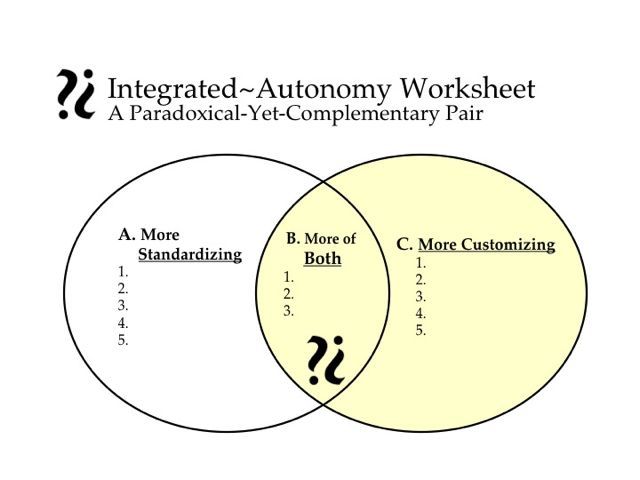![]() Integrated~Autonomy
Integrated~Autonomy
Move from Either-or to Robust Both-and Solutions (80 min.)
There are two kinds of truth. There are superficial truths, the opposite of which are obviously wrong. But there are also profound truths, whose opposite are equally right. – Niels Bohr
What is made possible? You can help a group move from either-or conflicts to both-and strategies and solutions. You can engage everyone in sharper strategic thinking, mutual understanding, and collaborative action by surfacing the advantage of being both more integrated and more autonomous. Attending to paradox will reveal opportunities for profound leaps in performance by addressing questions such as: What mix of integrative control and autonomous freedom will advance our purpose? Where do our needs for global fidelity and consistency meet the needs for local customization and creative adaptability? This makes it possible to avoid bipolar swings in strategy that are frequently experienced by many organizations.
Five Structural Elements – Min Specs
1. Structuring Invitation
- Invite your group to explore the questions, “Will our purpose be best served by increased local autonomy, customization, competition, and freedom among units/sites? Or, will our purpose be best served by increased integration, standardization, and control among units/sites? Or, both?”
2. How Space Is Arranged and Materials Needed
- Chairs for people to sit in groups of 4, with or without small tables
- An “Integrated Autonomy Worksheet” for each participant and a large one on the wall.
- Paper for recording activities and action steps
3. How Participation Is Distributed
- All central unit leaders and local unit leaders involved in the challenge at hand are included
- Everyone has an equal opportunity to contribute
4. How Groups Are Configured
- Individually to generate topics
- Small groups of 4
- Whole group
5. Sequence of Steps and Time Allocation
- Introduce the idea of Integrated~Autonomy for the topic at hand by asking, “How is it that we can be more integrated and more autonomous at the same time?” Have examples from past experience ready for sharing. 5 min.
- Use 1-2-4-All to generate a list of activities that require attention by asking, “Where is there tension between our desire to standardize and the request for more customizing or autonomy?” 10 min.
- Ask participants to work in groups of four, and pick one activity from the list and ask, “What is the rationale for standardizing? What is the rationale for customizing?” 10 min.
- Using 1-2-4 develop action steps that achieve standardization. Using 1-2-4, develop action steps that achieve customization. 10 min.
- Ask, “Which actions boost both standardization (group A) and customization (group C)?” See worksheet below. 5 min.
- Ask, “What modifications or creative ideas can be adopted to move some actions from group A to group B or from group C to group B?” See worksheet below. 15 min.
- Using 1-2-4-All, prioritize the most promising actions that promote both integration and autonomy. 10 min.
- Refine action steps by developing some effective Liberating Structures strings
Below: Presentation materials we use to introduce Integrated~Autonomy

WHY? Purposes
- Develop innovative strategies to move forward.
- Avoid wild or “bipolar” swings in policies, programs, or structures.
- Identify the complementary-yet-paradoxical pairs that are important and manage the paradoxical decisions productively.
- Evaluate decisions by asking, “Are we boosting or attending to both sides?”
- Evaluate and launch new strategies
Tips and Traps
- A productive starting question has balance and sparks curiosity or a search for what is working. Avoid making one side of the wicked question bad or less valuable to success such as, “How does our effort to be ONE integrated organization squash local autonomy?” Instead make your question equally appreciative of both sides, “How is it that we are both integrated and autonomous in our current operations?”
- Draw on field experience and imagination in asking questions such as, “How can we do more of both?”
- The goal is fidelity in a few core global attributes and differentiation in each local setting
- Laughter and groans (e.g., arrgh) help to identify progress
- You may need to encourage the group to try many experiments simultaneously
- There often are no quick fixes and you may need to return to the challenge periodically with additional rounds of Integrated~Autonomy
- When you start, the creative tension between the central and the local sides is relatively invisible. If the group gets stuck or starts to argue, tell each side to put on the hat of the other side and argue the opposite point of view.
Riffs and Variations
- Making progress with Integrated~Autonomy can shift what is possible for the whole organization as people start to understand that what helps them succeed in addressing a particular challenge applies across the board. Whenever this happens, use Min Specs to go deeper into must dos and must not dos.
- Substitute collaboration and competition for integration and autonomy
Examples
- For hospital-system leaders to develop the contents of new management contracts for small hospitals in the same region
- For a group of political leaders trying to formulate what should be legislated at the federal level and what should be decided locally
- For infection-control experts trying to create hospital-wide policies that do not inhibit unit-based innovations
Attribution: Liberating Structure developed by Henri Lipmanowicz and Keith McCandless.
